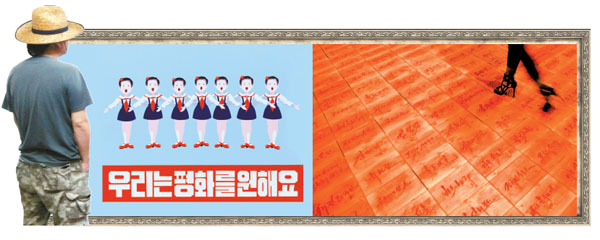Defector is an artist with no homeland, face or even name

From left, the back of Sun Mu, a North Korean defector and artist active in South Korea, who never reveals his real name or shows his face, superimposed on a painting now on display at the MMCA Seoul and his installation at SeMA. By Oh Sang-min
The opening was thrown into turmoil. The Chinese police, who were alerted to the show by the North Korean Embassy in China, which strives to bring defectors back, searched the museum and confiscated nearly 80 artworks by Sun Mu and 1,000 copies of the exhibition catalogue. South Korean guests at the opening urgently sent text messages by smartphone to the artist telling him not to come to the museum. Sun Mu fled and returned to South Korea.
In 1998, Sun Mu was waiting near the Tumen River, a border between North Korea and China, for some relatives living in China. They had promised to bring him food for his family. Tired of waiting, he impulsively crossed the river, which began an indefinite separation from his family in North Korea.
He arrived in South Korea in 2002 after traveling via China, Laos and Thailand. He had attended an art college in the North, so he went to Hongik University, which has one of the top art programs in the South. He majored in painting and got a bachelor’s degree in 2007 and a master’s in 2009. Following a joint exhibition with photographer Noh Suntag in 2007, Sun Mu has held several solo shows here.
“When I visit China, I have a sudden flash of memory of hard times when I had no name and no homeland,” Sun Mu said when the JoongAng Ilbo met him in his studio near Haengju Sanseong fortress in Gyeonggi. “That is why I focused on the Beijing exhibition. I wanted to exhibit my works nicely there even if they could be shown only for a week or a day. I anticipated it wouldn’t be easy, but I didn’t imagine they could be harsh to this extent.”
Twelve years have passed since he came to the South, but some things have not changed. His homeland is gone. He still doesn’t have a name. Sun Mu is a pseudonym. He never reveals his real name for fear of causing harm to his family in North Korea. He won’t allow his face to be photographed.
The name Sun Mu is the reverse of Mu Sun, a pseudonym proposed for him by South Korean artist Lee Yong-baek. Mu Sun means “no line” which reflects the hope that someday there will be no line separating the two Koreas.
Korea recently celebrated the 70th anniversary of liberation from Japanese colonial rule. But it is also the 70th year since the Korean Peninsula was divided. Art exhibitions that look back at the history are reflecting both of these themes. Sun Mu is the only artist who was invited by two major art museums - the National Museum of Modern and Contemporary Art (MMCA) and the Seoul Museum of Art (SeMA) - to show works at parallel exhibitions about the 70th anniversary.
Among the 270 works on display at the MMCA Seoul’s “Uproarious, Heated, Inundated” exhibition, Sun Mu’s paintings form the finale. Modelled after a North Korean propaganda poster, he painted children dancing in perfect order and wrote “We want peace” below them.
At SeMA’s “North Korea Project,” Sun Mu is showing an installation work. The work consists of a group of wooden boards on which there are carved phrases such as “political prisoner camps,” “Kim Jong-il” and “strong and prosperous country.” To pass through the exhibition room, visitors walk on the boards.
Visitors to Sun Mu’s studio are met with many colorful paintings. In a painting with dancing North Korean children wearing school uniforms, the phrase “Nothing to Envy” was written below the figures. The uniform facial expressions of the children - exaggerated pretenses of happiness - seem to foresee a creepy future for the country and its people.
“It would be great if North and South Korean people gathered together for a drink. It would be so much fun if we make a bomb shot [boilermaker] with a North Korean beer and South Korean soju,” Sun Mu said.
Although Sun Mu has had interviews with the international press - the New York Times, Der Spiegel and BBC - his paintings have been treated both warmly and coldly. His painting of Kim Il Sung at the 2008 Busan Biennale was pulled down.
“I do not take either side,” he said. “Even if I had propagandized for a certain organization or a dictator before, now I propagandize in favor of myself. I maintain neutrality about the two Koreas as a cosmopolitan.”
The North and South Korean flags hang from the ceiling of his studio.
“I planned a performance in which children would unbind these flags for the canceled opening of the exhibition in Beijing,” he said. “I don’t know how much influence the arts can have, but still I’d like to change the world with my paintings.”
BY KWON GEUN-YOUNG
[estyle@joongang.co.kr]










with the Korea JoongAng Daily
To write comments, please log in to one of the accounts.
Standards Board Policy (0/250자)